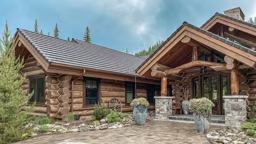
When the decision is made to have a second home, it’s reason to celebrate. It’s also an opportunity to try some ideas that work for a primary residence but in a second home can provide more free time. Often we ask more of a second home in how it will be used — whether we’re planning to offer it as a time-share when not used by the homeowner or as a future retirement home or even as a business retreat. But for the majority of log-home owners lucky enough to have that second home, we’re looking at it as a getaway — a respite from the rigors of normal, daily life.
From the first rough sketches through the placement of the final accessory, a second home is usually very personal to its owners. While you may need to present a certain facade in a primary residence that will also host business dinners or multi-function social events, a second home represents a chance to kick back and tell the world who you really are. Or tell them to take a flying leap because you are truly home. The objective of making a second home a place of relaxation and recharging also means avoiding the dread of additional work and maintenance concerns. Unless there are caretakers available, you’ll want to employ some clever, but simple tricks that are likely to make your (second) life a little easier.
Keep your floor plan open.
One of the most appealing aspects of log homes for many years now has been the open floor plan, where most of the public space flows rather than delineates. But just as nothing regarding style stays static, plans for all types of homes are featuring more defined rooms, particularly as people realize they need specific space for family members’ tasks and interests. But in a second home, it’s truly family and friends time, so keeping space open propels more interaction with any and all who are there. From a maintenance standpoint, there are fewer walls, built-ins and often fewer furnishings as well to require care. You are also less likely to close off a room and let it get messy or cluttered if you keep things open and airy.
Avoid clutter and furnishings that encourage clutter.
It’s a second home. You’re on vacation. So why would you want to spend time dusting a collection of some kind? Or wasting precious hours trying to figure out what to do with things you only thought you needed? If you are going to surround yourself with memorabilia, place your treasures in glass-enclosed cases that will minimize the need to clean or at least make dusting less frequent. For less attractive items or things that don’t need to be shown off, such as magazines, books, video games, scrapbooks and such, make sure you have plenty of drawers, cabinets or hideaway places, so you aren’t nagged by things that need straightening or that cause the mumbled “excuse the mess” when company drops by.
Keep window treatments simple.
Draperies and curtains are lovely, but they gather dust over time, and it seems to be worse in a home that isn’t used on a daily basis. Perhaps we keep the dust stirred up if there’s movement and activities, but a big part of that not-lived-in smell when you arrive after several weeks’ absence can be attributed to trapped dust in fabric, especially at the window. If you want to keep windows covered while you are gone so it’s not possible for the curious to walk up and look inside to confirm you’re not there, then the good old standard is the blind. But use verticals or the wider-slatted plantation style. Mini-blinds collect dust faster than draperies, in fact. It can be easier to wash curtains than mini-blinds.
Keep furniture fabrics simple, too.
Leather is wonderful. It not only gains character as it ages, but also is so easy to chase away dust. Avoid large loop or grained fabric, as dust and dirt will settle into divots. Then the first time somebody plops down, the cloud will billow out. Not only is it embarrassing and hard on the sinuses, but it’s also downright unhealthy. Tightly woven cloth with a stain treatment on it will provide a longer, more pleasant life from the furnishings.
Avoid fussy artwork and accessories.
Every home needs some items that stamp it truly your own. Often that’s by way of art and accessories. But think carefully about what (and how much) you want. And if you are thinking about an antler chandelier, recall that it will require cleaning from time-to-time. Same with wildlife trophies. Or intricate sculpture. If you can hire a cleaning service, no problem. If you have to do it yourself, how much of your vacation or weekend do you want to spend on a ladder with a feather duster?
Make storage space work harder.
Most log-home fans don’t skimp on closets and storage space when planning a home, and that’s good. But by including shelving, racks and hooks, it’s possible to make use of vertical space as much as the horizontal. And if a home is going to sit unused for periods of time, it’s possible to reduce clean-up time by ensuring that recreational items can be stored. Having a food freezer can be a great idea, maybe even more so than you’ll need one at your primary home. In fact, for food and toiletry storage, it pays to give considerable thought to how to ensure that anything left behind will be kept in a manner that doesn’t invite insects and creepy-crawlies.








_11868_2024-09-17_08-44-256x288.avif)


